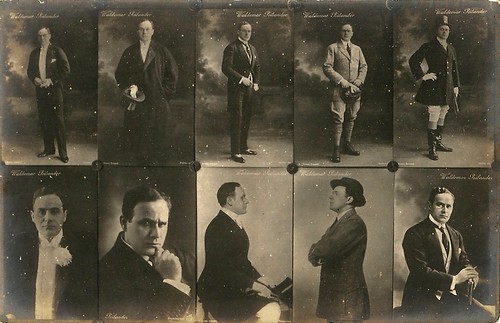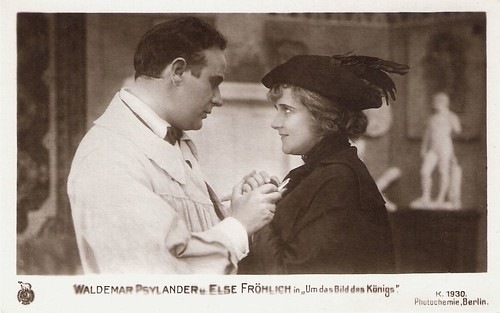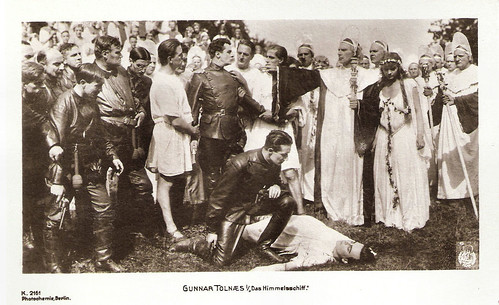Every Thursday this summer, EFSP will post on a film book (I waited one day with this post because of the passing of Rutger Hauer). Last month, at the Il Cinema Ritrovato Book Fair in Bologna, I found 'Nordisk Films Kompagni 1906-1924: The Rise and Fall of the Polar Bear'. It is a scholarly study by Isak Thorsen published in the KINtop series on early cinema. The Danish Nordisk company was one of the film studios that dominated the global film market during the 1910s. How did the Danes manage to do that? Why did it go wrong with Nordisk's international aspirations in the 1920s? And my personal cliffhanger: will my earlier post on Nordisk be 'scholarly approved'?

Book cover for Isak Thorsen, 'Nordisk Films Kompagni 1906-1924. The Rise and Fall of the Polar Bear' (2017). Series KINtop Studies in early cinema, Volume 5. Publisher: John Libbey Publishing Ltd..
Although Isak Thorsen's book is based on his 2009 Phd Dissertation, 'The Rise and Fall of the Polar Bear' reads like an exciting and fascinating adventure novel. Central character is a man called Ole Olsen. In 1906 he founded the company which soon became an international enterprise. Until 1924, when Olsen stepped down we follow through all kinds of historical documents how he organised his film studio as a business organisation, during a period that knew more radical changes than any other era in film history.
Ole Olsen (1863-1943) must have been quite a character. He was founder, sole proprietor, then director general and general of the board, and finally rank-and-file member of the board. Olsen was the guy who took all the smart decisions. He was the typical self-made-man with many enterprises behind him. On the fairgrounds, Olsen had performed in 1895 with an x-ray machine through which you could see your own bones. From such a sensational innovation to the cinema must have been a small step for him and in 1898 Olsen was one of the first to show motion pictures in Sweden.
In 1905 he became co-owner of the second cinema in Copenhagen, Biograf-Theatret, which soon became popular among the Danes. But Olsen did not have enough film titles to show, so he decided to make his own films. On 8 January 1906, Olsen presented under the label of Nordisk a film in two parts, Maagerne fodres i Orstedsparken/Seaguls are fed in the H.C. Orstedsparken. Soon followed actualities, comedies, travelogues, industrial films, sports films etc.
In less than a year, Ole Olsen owned a printing laboratory, a studio and a branch office of Nordisk in Berlin. Like many other film pioneers Olsen was a lawless cowboy. In 1907 he bought two lions at the Haagenbeck Zoo in Hamburg and at the island of Elleore, his film crew shot a film about two big game hunters, Lovejagten/The Lion Hunt (Viggo Larsen, 1907). Although the government and animal organisations had protested, the two lions were killed for the film. The scandal in Denmark caused a world-wide success. The film was Nordisk's breakthrough to the international market.
It is fascinating to read how Nordisk grew and innovated itself. Thorsen explains that one of the reasons why Nordisk would play a decisive role in the European film industry of the 1910s was that Ole Olsen solved a fundamental problem of the industry - the enormous overproduction of films. Nordisk became one of the first film companies to base major parts of its production on multiple-reel films. It lead to a sweeping revolution in the production, distribution and exhibition of films.
Another Danish studio, Fotorama, presented a white slave trade drama with the exceptional length of 706 metres, ca. 35 minutes. It was a huge success in Copenhagen. Again Olsen acted as a cowboy in the Wild West and let his director August Blom copy the film, scene for scene. Less then four months later, Nordisk presented a nearly identical film Den hvide slavehandel/The White Slave Trade (August Blom, 1910), same title, same length, even same camera angles. And of course Nordisk's version became the international hit.

Viggo Larsen. German postcard by Verlag Herm. Leiser, Berlin, no. 5344.

Valdemar Psilander. German postcard. Psilander appeared in his first Nordisk Film feature, Ved fængslets port/Temptations of a Great City (August Blom, 1911). He made more than eighty Nordisk Film features and was considered to be one of the greatest (and best paid) film stars of his time.

German postcard by Photochemie, Berlin, K. 1450. Photo: Nordisk Film. Valdemar Psilander in Manden uden Fremtid (Holger-Madsen, 1916). The German title was Prinz im Exil (Prince in exile).

German postcard by Photochemie, Berlin, no. K. 1475. Photo: Nordisk. Lilly Jacobson in Maharadjahens Yndlingshustru/The Maharaja’s Favourite Wife (Robert Dinesen, Svend Gade, 1917).

German postcard by Photochemie, Berlin, no. K 1914. Photo: Nordisk. Valdemar Psilander in Das Geheimnis der Sphinx, German release title for Sfinxens Hemmelighed/The Secret of the Desert (Robert Dinesen, 1918).
What caused Nordisk's demise? Several scholars wrote that the quality of the Nordisk films caused the fall of the polar bear. As a true scholar, Isak Thorsen adds some question marks to this point of view.
In 1913, Olsen himself wrote a circular to his directors in which he warned them that their productions had become "weaker than ever before". He wrote that he was prepared to sack the whole staff unless the directors produced better work, which was "worthy of the company standards". In 1913, American films had begun to gain a foothold in the European cinemas and nearby in Sweden, Scandinavian directors like Mauritz Stiller, Victor Sjöström and Benjamin Christensen had started to make their masterpieces which received much acclaim.
But still, Thorsen says no scholar can prove that the quality of the Nordisk films really went downhill in these years, simply because only a small part of the films has survived. In fact he shows based on many documents that in fact Nordisk did pretty well economically during the war years. In 1918 Nordisk produced 65 films and that's not bad indeed. But two years later the studio produced only 12 films and in the following years even less. What was the reason?
In the post-war years, Nordisk suffered from the loss of the Russian market. And Olsen's grand plan for taking control of UFA in association with the American Famous Players fell flat. The studio lost control over its most important markets and therefore Olsen decided to quit his studio in 1924.
So not the poor quality of the films caused the downfall of Nordisk as an international enterprise, but the changing international situation. Isak Thorsen's impressive book stops in 1924 but if you want to know what happened with the Polar Bear in the following decades, please read our earlier post on Nordisk.
And yes, I could not find many mistakes in our little post after reading this well documented study.

German postcard by Photochemie, Berlin, no. K. 1918. Photo: Nordisk Film Co. Valdemar Psilander in Favoriten (Robert Dinesen, 1917), released in Germany as Der tote Automobilist (The dead driver).

German postcard by Photochemie, Berlin, no. K.1933. Photo: Nordisk Film Co. Gunnar Sommerfeldt in Gillekop (August Blom, 1919). The script was written by Carl-Theodor Dreyer, based on a novel by Harald Tandrup.

German postcard by Photochemie, Berlin, no. K. 1943. Photo: Nordisk Films. Valdemar Psilander and Else Fröhlich in Rytterstatuen (A.W. Sandberg, 1919), Its German release title was Um das Bild des Königs (For the king's statue).

German postcard by Photochemie, Berlin, no. K. 2161. Photo: Nordisk. Publicity still for Himmelskibet/Das Himmelschiff/A Trip to Mars (Holger-Madsen, 1918) with Gunnar Tolnaes as Avanti Planetaros, Philip Bech as the Martian leader, Lilly Jacobsson as Marya, the Martian leader's daughter, Alf Blütecher (kneeling) as his friend Dr. Krafft and Nils Asther as the fallen Martian.

German postcard by Photochemie, Berlin, no. K. 2994. Photo: Nordisk. Gunnar Tolnaess in Maharadjahens Yndlingshustru/The Maharaja’s Favourite Wife (Robert Dinesen, Svend Gade, 1917) or one of its sequels.

German postcard by Photochemie, Berlin, no. K. 3129. Photo: Nordisk Film Co. Gunnar Tolnaess and Gerhard Jessen in Lykkelandet (Emanuel Gregers, 1919), released in Germany as Die Fahrt ins Glücksland (The trip to the lucky country).
In 1915, Gunnar Tolnaess had moved from Sweden to Denmark, where he was offered a contract at the Nordisk studio. He was immediately successful with Doktor X/Doctor X (Robert Dinesen, 1915). Nordisk hoped that Tolnaes would become as popular as their biggest star, Valdemar Psilander.
Among Tolnaes' successes were Maharadjahens Yndlingshustru I/The Maharajah's Favourite Wife I (Robert Dinesen, 1917), Den mystiske tjener/The mysterious servant (A.W. Sandberg, 1917) and the Science-Fiction film Himmelskibet/A Trip to Mars (Holger Madsen, 1918).
In the 1920s, Gunnar Tolnaess often worked with famous Danish director A.W. Sandberg.

Book cover for Isak Thorsen, 'Nordisk Films Kompagni 1906-1924. The Rise and Fall of the Polar Bear' (2017). Series KINtop Studies in early cinema, Volume 5. Publisher: John Libbey Publishing Ltd..
A European cowboy goes lion hunting
Although Isak Thorsen's book is based on his 2009 Phd Dissertation, 'The Rise and Fall of the Polar Bear' reads like an exciting and fascinating adventure novel. Central character is a man called Ole Olsen. In 1906 he founded the company which soon became an international enterprise. Until 1924, when Olsen stepped down we follow through all kinds of historical documents how he organised his film studio as a business organisation, during a period that knew more radical changes than any other era in film history.
Ole Olsen (1863-1943) must have been quite a character. He was founder, sole proprietor, then director general and general of the board, and finally rank-and-file member of the board. Olsen was the guy who took all the smart decisions. He was the typical self-made-man with many enterprises behind him. On the fairgrounds, Olsen had performed in 1895 with an x-ray machine through which you could see your own bones. From such a sensational innovation to the cinema must have been a small step for him and in 1898 Olsen was one of the first to show motion pictures in Sweden.
In 1905 he became co-owner of the second cinema in Copenhagen, Biograf-Theatret, which soon became popular among the Danes. But Olsen did not have enough film titles to show, so he decided to make his own films. On 8 January 1906, Olsen presented under the label of Nordisk a film in two parts, Maagerne fodres i Orstedsparken/Seaguls are fed in the H.C. Orstedsparken. Soon followed actualities, comedies, travelogues, industrial films, sports films etc.
In less than a year, Ole Olsen owned a printing laboratory, a studio and a branch office of Nordisk in Berlin. Like many other film pioneers Olsen was a lawless cowboy. In 1907 he bought two lions at the Haagenbeck Zoo in Hamburg and at the island of Elleore, his film crew shot a film about two big game hunters, Lovejagten/The Lion Hunt (Viggo Larsen, 1907). Although the government and animal organisations had protested, the two lions were killed for the film. The scandal in Denmark caused a world-wide success. The film was Nordisk's breakthrough to the international market.
It is fascinating to read how Nordisk grew and innovated itself. Thorsen explains that one of the reasons why Nordisk would play a decisive role in the European film industry of the 1910s was that Ole Olsen solved a fundamental problem of the industry - the enormous overproduction of films. Nordisk became one of the first film companies to base major parts of its production on multiple-reel films. It lead to a sweeping revolution in the production, distribution and exhibition of films.
Another Danish studio, Fotorama, presented a white slave trade drama with the exceptional length of 706 metres, ca. 35 minutes. It was a huge success in Copenhagen. Again Olsen acted as a cowboy in the Wild West and let his director August Blom copy the film, scene for scene. Less then four months later, Nordisk presented a nearly identical film Den hvide slavehandel/The White Slave Trade (August Blom, 1910), same title, same length, even same camera angles. And of course Nordisk's version became the international hit.

Viggo Larsen. German postcard by Verlag Herm. Leiser, Berlin, no. 5344.

Valdemar Psilander. German postcard. Psilander appeared in his first Nordisk Film feature, Ved fængslets port/Temptations of a Great City (August Blom, 1911). He made more than eighty Nordisk Film features and was considered to be one of the greatest (and best paid) film stars of his time.

German postcard by Photochemie, Berlin, K. 1450. Photo: Nordisk Film. Valdemar Psilander in Manden uden Fremtid (Holger-Madsen, 1916). The German title was Prinz im Exil (Prince in exile).

German postcard by Photochemie, Berlin, no. K. 1475. Photo: Nordisk. Lilly Jacobson in Maharadjahens Yndlingshustru/The Maharaja’s Favourite Wife (Robert Dinesen, Svend Gade, 1917).

German postcard by Photochemie, Berlin, no. K 1914. Photo: Nordisk. Valdemar Psilander in Das Geheimnis der Sphinx, German release title for Sfinxens Hemmelighed/The Secret of the Desert (Robert Dinesen, 1918).
The fall of the polar bear
What caused Nordisk's demise? Several scholars wrote that the quality of the Nordisk films caused the fall of the polar bear. As a true scholar, Isak Thorsen adds some question marks to this point of view.
In 1913, Olsen himself wrote a circular to his directors in which he warned them that their productions had become "weaker than ever before". He wrote that he was prepared to sack the whole staff unless the directors produced better work, which was "worthy of the company standards". In 1913, American films had begun to gain a foothold in the European cinemas and nearby in Sweden, Scandinavian directors like Mauritz Stiller, Victor Sjöström and Benjamin Christensen had started to make their masterpieces which received much acclaim.
But still, Thorsen says no scholar can prove that the quality of the Nordisk films really went downhill in these years, simply because only a small part of the films has survived. In fact he shows based on many documents that in fact Nordisk did pretty well economically during the war years. In 1918 Nordisk produced 65 films and that's not bad indeed. But two years later the studio produced only 12 films and in the following years even less. What was the reason?
In the post-war years, Nordisk suffered from the loss of the Russian market. And Olsen's grand plan for taking control of UFA in association with the American Famous Players fell flat. The studio lost control over its most important markets and therefore Olsen decided to quit his studio in 1924.
So not the poor quality of the films caused the downfall of Nordisk as an international enterprise, but the changing international situation. Isak Thorsen's impressive book stops in 1924 but if you want to know what happened with the Polar Bear in the following decades, please read our earlier post on Nordisk.
And yes, I could not find many mistakes in our little post after reading this well documented study.

German postcard by Photochemie, Berlin, no. K. 1918. Photo: Nordisk Film Co. Valdemar Psilander in Favoriten (Robert Dinesen, 1917), released in Germany as Der tote Automobilist (The dead driver).

German postcard by Photochemie, Berlin, no. K.1933. Photo: Nordisk Film Co. Gunnar Sommerfeldt in Gillekop (August Blom, 1919). The script was written by Carl-Theodor Dreyer, based on a novel by Harald Tandrup.

German postcard by Photochemie, Berlin, no. K. 1943. Photo: Nordisk Films. Valdemar Psilander and Else Fröhlich in Rytterstatuen (A.W. Sandberg, 1919), Its German release title was Um das Bild des Königs (For the king's statue).

German postcard by Photochemie, Berlin, no. K. 2161. Photo: Nordisk. Publicity still for Himmelskibet/Das Himmelschiff/A Trip to Mars (Holger-Madsen, 1918) with Gunnar Tolnaes as Avanti Planetaros, Philip Bech as the Martian leader, Lilly Jacobsson as Marya, the Martian leader's daughter, Alf Blütecher (kneeling) as his friend Dr. Krafft and Nils Asther as the fallen Martian.

German postcard by Photochemie, Berlin, no. K. 2994. Photo: Nordisk. Gunnar Tolnaess in Maharadjahens Yndlingshustru/The Maharaja’s Favourite Wife (Robert Dinesen, Svend Gade, 1917) or one of its sequels.

German postcard by Photochemie, Berlin, no. K. 3129. Photo: Nordisk Film Co. Gunnar Tolnaess and Gerhard Jessen in Lykkelandet (Emanuel Gregers, 1919), released in Germany as Die Fahrt ins Glücksland (The trip to the lucky country).
In 1915, Gunnar Tolnaess had moved from Sweden to Denmark, where he was offered a contract at the Nordisk studio. He was immediately successful with Doktor X/Doctor X (Robert Dinesen, 1915). Nordisk hoped that Tolnaes would become as popular as their biggest star, Valdemar Psilander.
Among Tolnaes' successes were Maharadjahens Yndlingshustru I/The Maharajah's Favourite Wife I (Robert Dinesen, 1917), Den mystiske tjener/The mysterious servant (A.W. Sandberg, 1917) and the Science-Fiction film Himmelskibet/A Trip to Mars (Holger Madsen, 1918).
In the 1920s, Gunnar Tolnaess often worked with famous Danish director A.W. Sandberg.
No comments:
Post a Comment